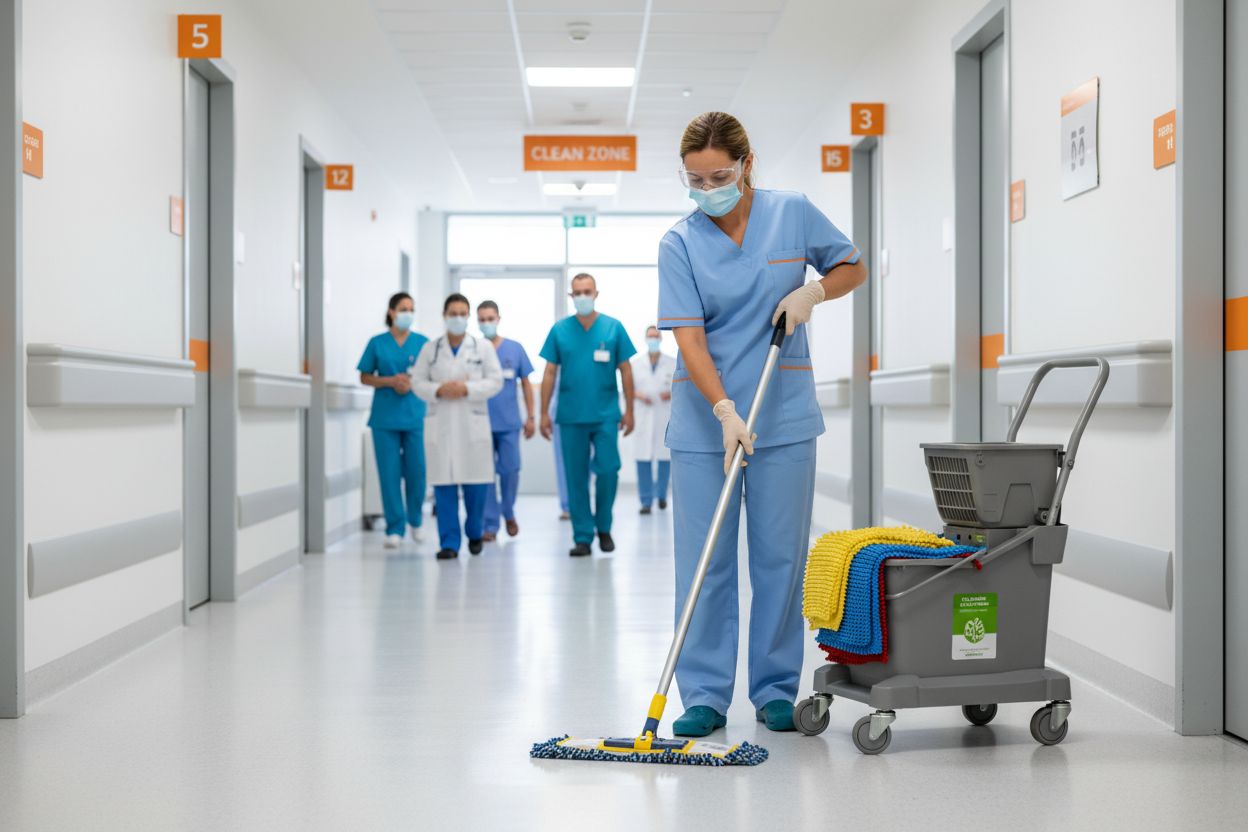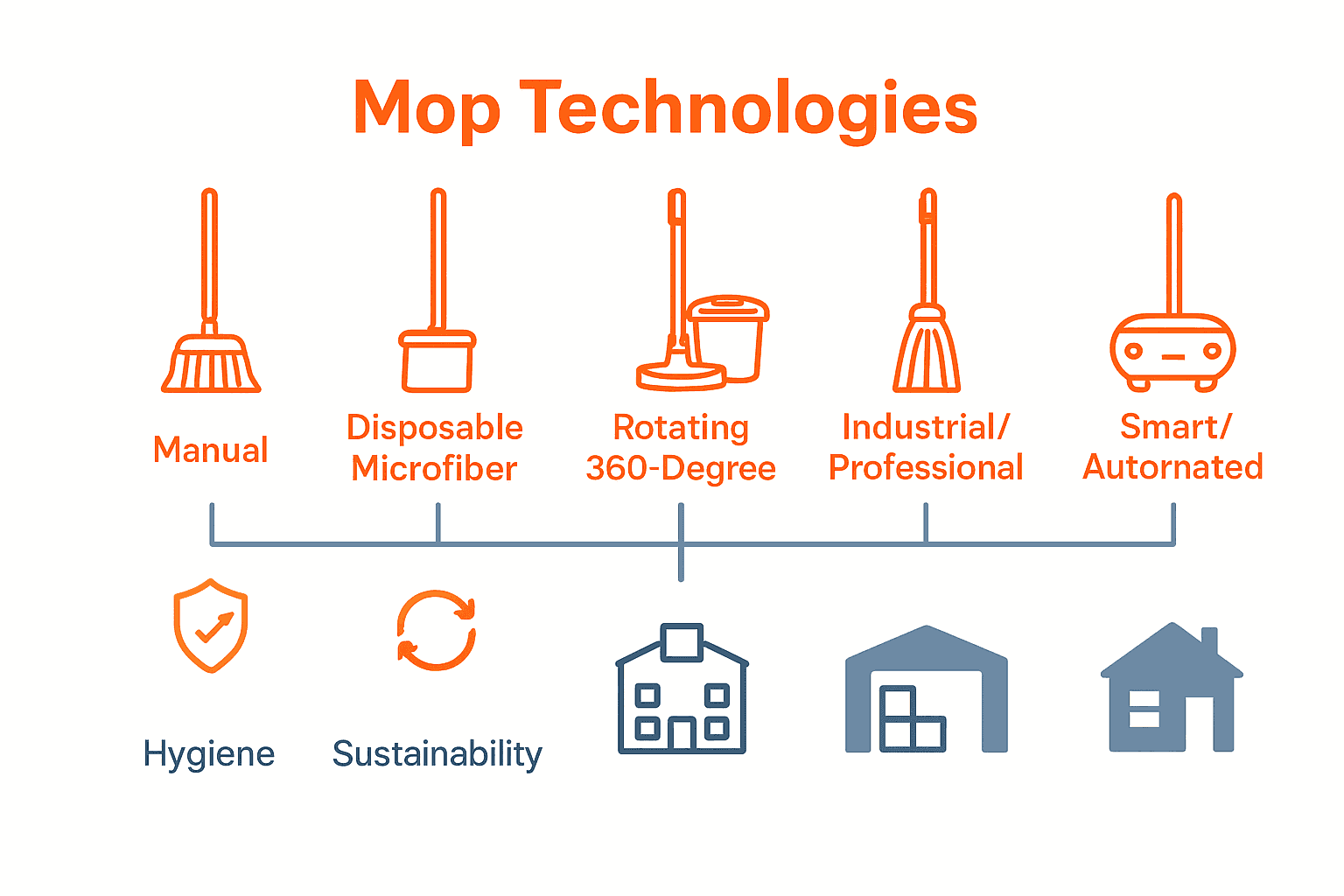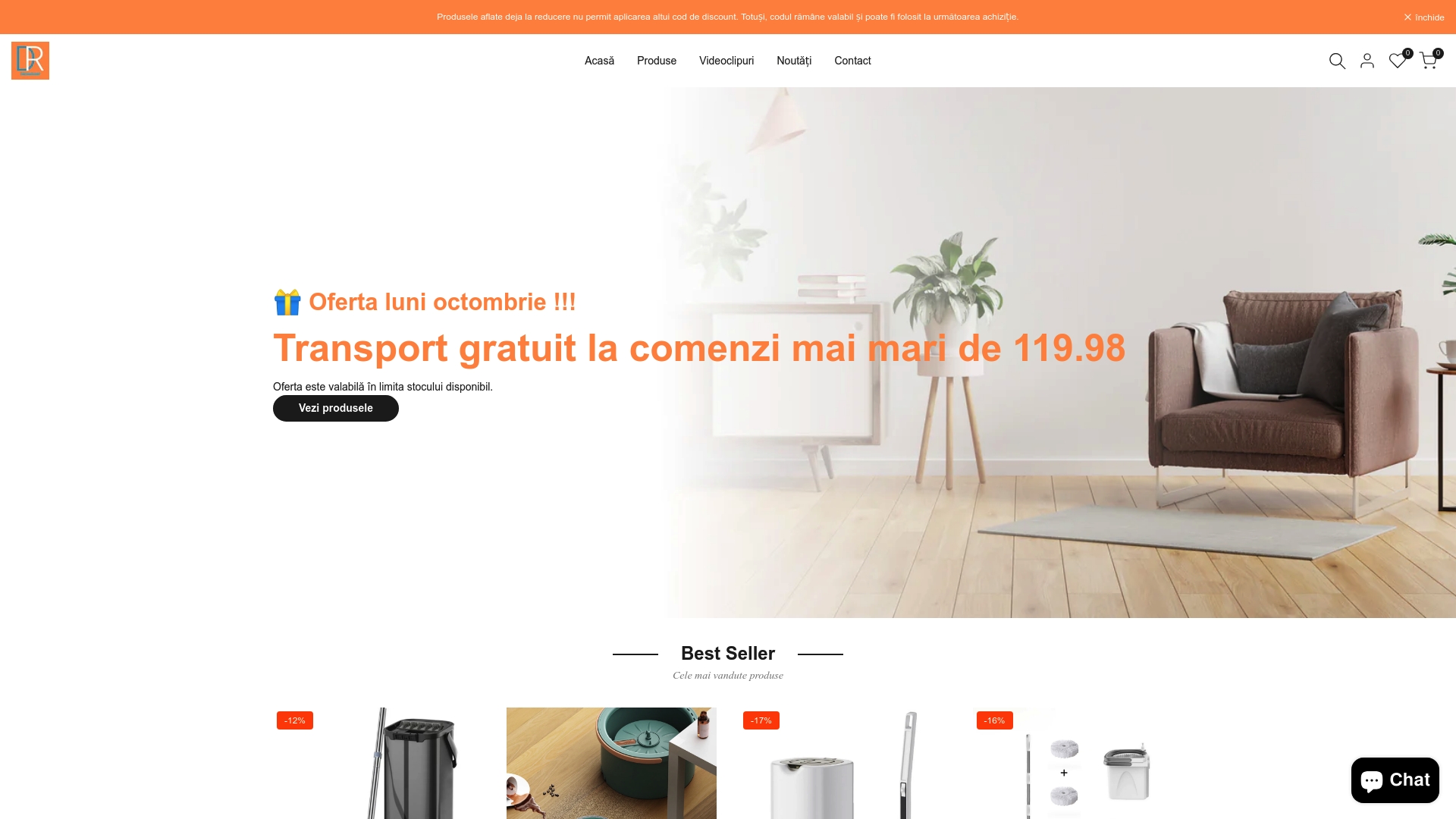Did you know that the European market for cleaning mops is projected to reach 900 million euros by 2028? With growing concerns about hygiene and sustainability, households and businesses are turning to smarter, more effective mop technologies. From advanced microfiber heads to app-controlled smart systems, today’s mops do more than just wipe floors—they deliver speed, efficiency, and cleaner spaces with less effort than ever before.
Key Takeaways
| Point | Details |
|---|---|
| Mop Technology Evolution | Modern mops have progressed beyond traditional designs, incorporating advanced materials and smart features for enhanced cleaning efficacy. |
| Diverse Mop Types | Various mop technologies are available to meet specific needs, including disposable, rotating, and smart mops tailored for both residential and commercial use. |
| Emphasis on Hygiene and Sustainability | Contemporary mops focus on superior hygiene standards, utilizing eco-friendly materials that minimize chemical use and promote sustainability. |
| Targeted Applications | Specialized mop technologies are essential in specific sectors like healthcare, hospitality, and industrial settings, addressing unique cleaning challenges efficiently. |
Table of Contents
- Defining Mop Technology And Core Concepts
- Types Of Mop Technologies Available Today
- How Modern Mops Work And Key Innovations
- Real-World Applications Across Different Settings
- Benefits, Common Pitfalls, And Buying Tips
Defining Mop Technology and Core Concepts
A mop is far more than just a simple cleaning tool - it’s an essential household and professional cleaning solution designed to efficiently remove dirt, liquid, and debris from various floor surfaces. According to Wikipedia’s cleaning tools overview, mops are fundamentally constructed from absorbent materials like cloth, sponge, or specialized yarn, strategically attached to a handling pole to maximize cleaning effectiveness and user comfort.
The modern mop technology encompasses several core design variations, each targeting specific cleaning needs. Traditional mop types include:
- String mops with loose cotton or synthetic fibers
- Sponge mops with replaceable rectangular cleaning heads
- Flat microfiber mops with slim, adaptable cleaning surfaces
- Rotating 360-degree mops with advanced water separation mechanisms
According to recent European market research, the cleaning industry increasingly emphasizes hygienic solutions. Modern mop technologies now prioritize materials like microfiber, which offer superior dirt absorption, faster drying times, and enhanced bacterial resistance compared to traditional cotton variants. This evolution reflects growing consumer demands for more efficient, sustainable cleaning tools that minimize water and chemical usage while maximizing cleaning performance.
Today’s mop technology represents a sophisticated blend of ergonomic design, advanced materials, and practical functionality. Whether for residential spaces or professional cleaning environments, these tools have transformed from simple floor-wiping instruments into intelligent cleaning solutions that adapt to diverse surface types and user needs.
Types of Mop Technologies Available Today
Mop technologies have dramatically evolved from traditional cleaning tools to sophisticated cleaning systems addressing diverse needs across residential and commercial environments. According to Market Intelo research, contemporary mop solutions now include eco-friendly and reusable sets made from innovative recycled and biodegradable materials, reflecting growing sustainability demands.
The primary mop technology categories include:
Here’s a comparison of the main types of mop technologies available today:
| Mop Type | Key Features | Typical Use Cases |
|---|---|---|
| Manual Mops | Cotton/microfiber heads Traditional design |
Homes General cleaning |
| Disposable Microfiber | Single-use High hygiene |
Healthcare Food services |
| Rotating 360-Degree | Water separation Spin system |
Quick cleaning Small businesses |
| Industrial/Professional | Heavy-duty Large capacity |
Warehouses Commercial spaces |
| Smart/Automated | App controls Sensors Robotic movement |
Hospitals Large office facilities |
- Manual Mops: Traditional string and flat designs with cotton or microfiber heads
- Disposable Microfiber Mops: Single-use, hygienic cleaning solutions
- Rotating 360-Degree Mops: Advanced designs with water separation mechanisms
- Professional Industrial Mops: Heavy-duty cleaning systems for commercial spaces
- Smart Cleaning Mops: Technology-integrated systems with automated features
Research from ESun News highlights the rising popularity of disposable microfiber mops, which offer significant advantages: superior dirt and germ trapping, reduced chemical usage, enhanced sustainability, and improved hygiene. These innovations are particularly crucial in environments with strict cleanliness standards, such as healthcare facilities, food service areas, and professional cleaning services.

Modern mop technologies represent a sophisticated blend of materials science, ergonomic design, and environmental consciousness.
 Auto-rinsing mops guide demonstrates how cleaning tools have transformed from simple floor-wiping instruments into intelligent, adaptable solutions that meet evolving consumer expectations for efficiency, convenience, and ecological responsibility.
Auto-rinsing mops guide demonstrates how cleaning tools have transformed from simple floor-wiping instruments into intelligent, adaptable solutions that meet evolving consumer expectations for efficiency, convenience, and ecological responsibility.
How Modern Mops Work and Key Innovations
Modern mop technologies have transformed cleaning from a mundane chore into an intelligent, efficient process driven by cutting-edge innovations. According to research from P Market Research, contemporary mops now incorporate advanced sensors, mobile app controls, and sophisticated design mechanisms that dramatically enhance cleaning performance.
Key technological innovations in modern mops include:
- Smart Sensor Systems: Automatically detect dirt levels and adjust cleaning intensity
- Mobile App Integration: Allow remote control and performance tracking
- Advanced Microfiber Materials: Enhance dirt and bacteria absorption
- Battery-Powered Cordless Mechanisms: Provide unlimited mobility
- Autonomous Navigation: Enable robotic mops to map and optimize cleaning routes
The European market has witnessed remarkable technological progression, as highlighted by MacLean Vac’s market analysis. Manufacturers like Vileda, Kärcher, and SharkNinja have introduced groundbreaking features such as adjustable steam output, quick-release cleaning heads, and dual-tank designs that prevent secondary contamination. Notably, Kärcher’s 2023 smart mop even includes app-controlled steam adjustment and advanced fault diagnosis capabilities.
These technological advancements represent more than incremental improvements. Rotating mop technologies demonstrate how modern cleaning tools have evolved into sophisticated systems that prioritize efficiency, hygiene, and user convenience. From antibacterial treatments to autonomous navigation, today’s mops are transforming cleaning from a manual task into an intelligent, data-driven process.
Real-World Applications Across Different Settings
Modern mop technologies have revolutionized cleaning practices across diverse environments, offering tailored solutions for specific sector needs. Market Intelo research highlights the strong adoption of eco-friendly and reusable mop sets in commercial sectors, driven by increasingly stringent hygiene regulations and sustainability requirements.
Key application areas for advanced mop technologies include:
- Healthcare Facilities: Specialized antimicrobial mops for infection control
- Hospitality Spaces: Quick-drying microfiber systems for rapid room turnovers
- Office Environments: Ergonomic designs minimizing cleaning time and effort
- Educational Institutions: Durable mops capable of handling high-traffic areas
- Industrial Settings: Heavy-duty mops with advanced chemical resistance
According to PRNewswire’s European market analysis, water scarcity in countries like Spain, France, and Italy has accelerated demand for innovative manual mops that conserve water. Additionally, labor shortages have pushed organizations to adopt efficient microfiber mops that dramatically reduce cleaning time and improve overall productivity.
Mop Selection Guide for Salons demonstrates how specialized mop technologies can transform cleaning processes across different professional environments. From healthcare-grade sanitization to sustainable commercial cleaning, modern mop technologies offer intelligent, adaptable solutions that address complex cleaning challenges while prioritizing efficiency, hygiene, and environmental responsibility.
Benefits, Common Pitfalls, and Buying Tips
Mop technologies offer transformative cleaning solutions with nuanced benefits and potential challenges. According to ESun News research, modern mop systems provide substantial advantages that extend far beyond traditional cleaning methods.
Key benefits include:
- Enhanced Hygiene: Trap significantly more dirt and germs
- Sustainability: Reduce chemical usage and environmental impact
- Cost-Effectiveness: Lower long-term maintenance expenses
- Efficiency: Minimize cross-contamination risks
- Versatility: Adaptable to multiple surface types
Market Intelo’s commercial sector analysis reveals critical buying considerations. When selecting mop technologies, prioritize products that satisfy stringent hygiene regulations while offering eco-friendly design. Common pitfalls to avoid include overlooking durability, neglecting material quality, and failing to match the mop’s capabilities with specific cleaning environment requirements.
Auto-rinsing mops guide recommends purchasing mops made from recycled or biodegradable materials, with robust construction and clear performance specifications. Smart buyers evaluate not just immediate cost, but long-term value—considering factors like replacement frequency, cleaning efficiency, and environmental sustainability. Pro tip: Always test mop performance on your specific surface types before full commitment.
Discover Advanced Mop Technology for a Cleaner Home Today
Are you struggling to keep up with evolving cleaning standards or feeling overwhelmed by outdated mop solutions that cannot trap dirt or bacteria effectively? The article explored how modern mop technologies like microfiber heads, smart sensors, and auto-rinsing frames are changing the cleaning experience in homes and businesses. Yet, choosing the right equipment can be confusing when so many options promise efficiency, sustainability, and better results.

Transform your cleaning routine now with DreamRamp.ro, the trusted source for powerful cleaning tools and innovative mop systems. Browse our user-friendly homepage to discover solutions that match your unique cleaning challenges. Our expertly curated range features electric and manual mops, water-separating bucket sets, and accessories designed to help you fight bacteria and maintain a healthier living space. Do not miss out on special offers and free delivery designed with your comfort in mind. Upgrade to the next generation of mop technology today by exploring DreamRamp.ro. Your cleaner, easier home starts with one smart choice right now.
Frequently Asked Questions
What are the different types of mop technologies available today?
The main types of mop technologies include manual mops, disposable microfiber mops, rotating 360-degree mops, industrial/professional mops, and smart/automated mops, each designed to meet specific cleaning needs.
How do modern mops enhance cleaning efficiency compared to traditional mops?
Modern mops incorporate advanced materials like microfiber and features such as smart sensors and mobile app controls, which allow for better dirt absorption, efficient cleaning processes, and reduced chemical usage.
What are the benefits of using microfiber mops?
Microfiber mops provide enhanced hygiene by trapping more dirt and germs, are more sustainable by requiring fewer chemicals, and are typically more cost-effective in the long run due to their durability and effectiveness in various cleaning tasks.
What should I consider when selecting a mop for commercial cleaning?
When selecting a mop for commercial cleaning, consider factors such as hygiene requirements, material quality, mop durability, and the specific cleaning environments it will be used in to ensure maximum efficiency and effectiveness.









